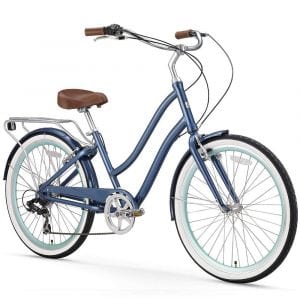The Best Bike

Our Review Process
Don't Waste Your Money is focused on helping you make the best purchasing decision. Our team of experts spends hundreds of hours analyzing, testing, and researching products so you don't have to. Learn more.
Our Picks For The Top Bikes
- 1. Dynacraft Front Fork Shock Linear Brakes Bike, 18-Speed
- 2. Mongoose Exlipse Hill Climbing Child’s Mountain Bike, 21-Speed
- 3. Schwinn Children’s Elm Girls Bike, 1-Speed
- 4. Swagtron Swagcycle EB5 Universal Portable Bike, 1-Speed
- 5. ANCHEER Motored LCD Display Commuter Bike, 24-Speed
- 6. Retrospec Beaumont Lady’s Urban City Commuter Bike, 7-Speed
- 7. Retrospec Urban Hand-Built Bike, 1-Speed
- 8. Huffy Comfort Lightweight Aluminum Commuter Bike, 7-Speed
- 9. ANCHEER Removable Lithium-Ion Battery Electric Commuter Bike, 3-Speed
- 10. sixthreezero EVRYjourney Men’s Ergonomic Commuter Bike, 7-Speed
- 11. Schwinn Wayfarer Unisex Classic Bike, 7-Speed
- 12. Razor RSF350 Rechargeable Electric Street Bike
- 13. Royce Union Lightweight Padded Velo Saddle Bike, 3-Speed
- 14. Huffy Women’s Panama Jack Commuter Bike, 1-Speed
- 15. Huffy Kid’s Adjustable Saddle Mountain Bike, 6-Speed
- 16. sixthreezero Around The Block Women’s Cruiser Commuter Bike, 1-21-Speed
- 17. sixthreezero EVRYjourney Women’s Retro Hybrid Bike, 3-Speed
Available in purple, red or black, this bike is designed to shine. It's best for teens and adults and features thick tires and 18 speeds to help you power through rough terrain. The handlebars have an excellent grip for better control, as well as built-in dual brakes to make stopping a breeze.
Most EconomicalWhen shopping on a budget, this affordable bike is the way to go.
Thanks to this bike's adjustable seat post, you'll be able to fit the bicycle to match your child's height. The bike features a steel frame that is not only durable, but also lightweight. More advanced riders will appreciate the front and rear linear pull brakes and the 21 speed options.
21 SpeedsOlder children who are more advanced riders would do well with this bike, which has 21 different speeds.
This bike was designed with younger riders in mind. It has a lighter frame and the cranks and pedals are located in a more forward position. Parents can even adjust the seat for a perfect fit. Included with the purchase is a front basket for holding toys, water bottles or cell phones.
Best for ChildrenBest for children ages six and up, this colorful bicycle comes with a matching basket.
This bike has a 250W rear hub motor and can operate as a full e-bike, power assist or standard bike. It can be folded three times to fit inside compact vehicles.
Electric Bike with Power AssistThis bike can go 15.5 miles on a single charge toggling between power assist and pedaling.
Buying Guide
If sitting in traffic every day isn’t your idea of fun, consider riding a commuter bike to work instead. That way, you can avoid all of the congestion while getting some exercise along the way. Not to mention, riding a bike is far more eco-friendly than driving in a car, so you’re also helping out the planet with your commute.
MORE: The Best Adult Bike Helmets
“Are you looking for a way to burn calories, be more active, improve your health and get some fresh air on your way to and from work? A commuter bike may be perfect for you,” says fitness expert Stephanie Mansour. “A commuter bike is used to travel to and from your work and home.”
With so many different bikes available, it’s hard to know which bike is the best for your commute. One of the most important things to consider is the length of your commute. This will affect what kind of bike you need and what kind of comfort requirements you’ll have. Also beware of the cycling conditions in your city, with respect to road conditions and cycling lanes.
“Unlike a recreational bike, a commuter bike needs to be comfortable for everyday use and the specific terrain on which your route will take you,” says Mansour. “Are you going up and down hills, in bike lanes within traffic, or through neighborhoods? Your route to and from work needs to be considered and kept n mind when purchasing a commuter bike. Also, what’s the weather like in your area? If you are dealing with rain, snow, or colder temperatures, a skinny tired bike is not the best for you.”
If your commute is under three miles, then you can use pretty much any kind of bike. If your commute is between three and six miles, you’ll want to pay special attention to the bike seat to ensure it’s comfortable. Plus, take note of the height of the handlebars and the bike itself, as they will need to fit you perfectly to avoid any pain. If your commute is a long one, around nine miles, opt for a bike that’s designed for speed and efficiency.
Another element to consider is the kind of tires you will need. If your bike has large, skinny tires, you’ll have a quick ride but your tires won’t do well in the rain. If you live in an area with lots of precipitation, then you may need something with a better grip. If your commute takes you over train or streetcar tracks, skinny tires are more likely to get stuck in the grooves.
Be sure to take a look at what kind of brakes your bike has. Rim brakes, which are inexpensive and light, are prone to slipping on wet surfaces. If you’re riding along wet roads often, this isn’t a good choice. On the other hand, these may work if your commute is consistently dry. Disc brakes are more costly and considerably heavier. They offer heavy-duty braking force and more safety than rim brakes.
Your bike should also be adjusted to fit your body, and you should always practice good posture while riding to and from work.
“Make sure the bike is comfortable for you,” says Mansour. “When you extend your legs down fully on each pedal, you still want to keep your knee slightly bent. You never want to fully extend your knee as you pedal down because this can cause you to hyperextend at the knee joint. You also want to make sure that as you ride the commuter bike, you’re able to pull your navel in toward your spine to keep your core tight. Finally, you want to make sure that your shoulders are back and relaxed instead of hunched forward on the bike handles.”
Our Expert Consultant

Certified Personal Trainer, Health and Wellness Expert
Stephanie Mansour, host of “Step It Up with Steph” on public broadcasting, has been coaching women for over a decade on how to lose weight and make it last. She has a Bachelor of Arts in communications with an emphasis on women’s studies and psychology from the University of Michigan. She holds certifications in life coaching, personal training, yoga and Pilates.
What to Look For
- When you’re in the market for a commuter bike, be sure to look at the size of the frame and the height of the wheels. Your height will determine which sizes you need, and many bike companies provide sizing charts you can review before you purchase, to ensure you’ve selected the right bike for you. The weight of the bike may be a purchasing factor for some commuters. If you live in a place where you need to store your bike indoors or have to carry it up and down stairs, you don’t want to get one that’s too heavy. Similarly, if you don’t have a bike lockup outside at work and need to carry it to another location, you’ll be thankful you got a lightweight bike. Pay attention to the frame of the bike, as you want to get one that’s durable. A steel or aluminum alloy frame is a good choice for a commuter bike because they are hardy and last a lifetime.
- The kind of seat your commuter bike can make all the difference when it comes to comfort. After a ride to work, you don’t want to start your tasks with a sore backside. Opt for a seat that is designed with comfort in mind and has plenty of padding.
- The height and shape of the bike’s handlebars affect your comfort level as well. If you’re consistently hunched over, you will end up with a sore back. Similarly, having to reach up to hold the handles will give you sore upper arms. Take a look at the design of the handles when selecting your commuter bike to ensure you sit in a natural and comfortable position when holding on to them.
More to Explore
There are many benefits to riding a commuter bike to work, even beyond getting to skip all the traffic. One of the biggest advantages is that you save time while getting some exercise. When you ride to work, you no longer have to stop at the gym afterward because you’ve already gotten in a great workout.
In addition to saving time at the gym, you can also save money when riding a bike to work. The cost of owning a car can be several thousands of dollars a year, while the cost of owning a bike is only around $300 a year.
In addition to saving on transportation costs, you may also be able to save on healthcare expenses. Riding a bike to work keeps you more fit than if you were sitting in a car. As a result, you may see more health benefits thanks to your daily exercise routine.
Did you know that riding a bike to work can lead to decreased stress and anxiety? Exercise, in general, helps people release pent-up negative energy, which in turn can help you sleep better at night and be in a better mood during the day.



























